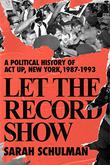I will never forget attending my first ACT UP meeting in the Great Hall of the Cooper Union in New York. It was the summer of 1991, and the AIDS activist organization was already famous for its theatrical demonstrations at the Food and Drug Administration, the New York Stock Exchange, and St. Patrick’s Cathedral, as well as its success in expediting drug testing and access, lowering the price of AZT, and forcing the scientific establishment to take it seriously. I had moved to the city the year before and recently come out; a gay friend had pointed me toward ACT UP—the guys were known to be smart and hot—and I wanted to do something to fight AIDS, then devastating the gay community.
I remember that the meeting was intimidating and inspiring in equal measure. I knew little about the pathogenesis of HIV, or the awful laundry list of opportunistic infections that people with AIDS battled, or the Byzantine process of drug approval, all subjects fluently discussed there. But the room was electric with energy and passion. The guys were as smart and hot as foretold. So were the lesbians and the odd straight people, the motley assortment of activists who convened there every Monday night. I was hooked.
 Sarah Schulman’s new book, Let the Record Show: A Political History of ACT Up New York, 1987-1993 (Farrar, Straus and Giroux, May 18), captures the feeling of walking into an ACT UP meeting for the first time, and her account—woven from an oral history project that she and Jim Hubbard conducted over 17 years—is just as cacophonous and enthralling. Fortunately, Schulman is a lucid guide to the complex politics and multiple issues that ACT UP took on, succinctly introducing readers to a varied cast of characters and allowing their voices and perspectives, sometimes contradictory, to predominate.
Sarah Schulman’s new book, Let the Record Show: A Political History of ACT Up New York, 1987-1993 (Farrar, Straus and Giroux, May 18), captures the feeling of walking into an ACT UP meeting for the first time, and her account—woven from an oral history project that she and Jim Hubbard conducted over 17 years—is just as cacophonous and enthralling. Fortunately, Schulman is a lucid guide to the complex politics and multiple issues that ACT UP took on, succinctly introducing readers to a varied cast of characters and allowing their voices and perspectives, sometimes contradictory, to predominate.
The story of ACT UP has been told before, most notably in David France’s 2016 book, How To Survive a Plague. Schulman, a prolific lesbian novelist, playwright, and nonfiction writer, has a different agenda. While most depictions of the group have focused on a handful of treatment activists—many of them gay White men—she pulls back the camera to show that the group, while largely White and gay, was more diverse than is often recognized. She reveals that the organization of ACT UP was cellular, with smaller affinity groups working on different projects simultaneously. She devotes large sections to two successful ACT UP campaigns that don’t often get the spotlight: the fight to expand the Centers for Disease Control’s definition of AIDS to include women’s infections (enabling more women with AIDS to receive benefits and participate in drug trials) and the fight for needle exchange (giving intravenous drug users access to clean needles, thus preventing HIV infections through needle sharing).
“This is a book in which all people with [AIDS] or with [HIV] are equally important,” Schulman writes. “Their experiences all matter. Therefore, their contributions to transforming the AIDS paradigm are represented as dynamic, interlocking parts of a bigger picture.” Though I was involved with ACT UP for nearly four years, I learned a tremendous amount from this book, which offered a broader view than it was possible for any one person to have at the time.
That ACT UP should have achieved what it did, against the odds, is nothing short of remarkable. Likewise, Let the Record Show, despite its enormous cast and jumble of storylines, is remarkably successful. Reading one chapter—like attending a Monday-night meeting for the first time—will leave you hooked.
Tom Beer is the editor-in-chief.



































